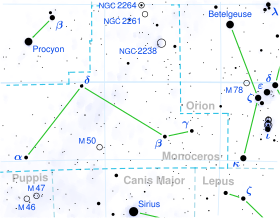Alpha Monocerotis
| Observation data Epoch J2000.0 Equinox J2000.0 (ICRS) | |
|---|---|
| Constellation | Monoceros |
| Right ascension | 07h 41m 14.832s[1] |
| Declination | −09° 33′ 04.078″[1] |
| Apparent magnitude (V) | 3.94[2] |
| Characteristics | |
| Spectral type | G9.5 III-IIIb Fe-0.5[3] |
| B−V color index | 1.022[2] |
| Astrometry | |
| Radial velocity (Rv) | 11.66±0.06[4] km/s |
| Proper motion (μ) | RA: -74.989 mas/yr[1] Dec.: -19.838 mas/yr[1] |
| Parallax (π) | 22.3839 ± 0.1348 mas[1] |
| Distance | 145.7 ± 0.9 ly (44.7 ± 0.3 pc)[1] |
| Absolute magnitude (MV) | 0.71±0.08[5] |
| Details | |
| Mass | 2.25±0.13[4] M☉ |
| Radius | 10.42±0.12[6] R☉ |
| Luminosity | 63.7±1.3[6] L☉ |
| Surface gravity (log g) | 2.79±0.04[4] cgs |
| Temperature | 5049±32[6] K |
| Metallicity [Fe/H] | −0.04±0.03[4] dex |
| Rotation | 326 days[7] |
| Rotational velocity (v sin i) | 0.92±0.45[4] km/s |
| Age | 890±180[4] Myr |
| Other designations | |
| Database references | |
| SIMBAD | data |
Alpha Monocerotis, Latinised from α Monocerotis, is the Bayer designation for the brightest star in the equatorial constellation of Monoceros. It can be viewed with the naked eye, having an apparent visual magnitude of 3.94.[2] Based upon an annual parallax shift of 22.4 mas as seen from Earth,[1] it is located 146 light-years away from the Sun. The star is moving away from the Sun with a radial velocity of +11.7 km/s.[4]
The stellar classification of G9.5 III-IIIb Fe-0.5[3] indicates this is an evolved giant star of type G, which means the hydrogen has been depleted at its core and the outer envelope has expanded and cooled. The 'Fe−0.5' notation indicates the spectrum displays a slight underabundance of iron relative to other stars of this temperature. It is a red clump giant, which means it is generating energy through helium fusion at its core.[9] At the age of 890 million years, this yellow-hued star has an estimated 2.2 times the mass of the Sun[4] and 10 times the Sun's radius.[6] It is spinning sedately with a rotation period of about 326 days.[7]
References
[edit]- ^ a b c d e f Vallenari, A.; et al. (Gaia collaboration) (2023). "Gaia Data Release 3. Summary of the content and survey properties". Astronomy and Astrophysics. 674: A1. arXiv:2208.00211. Bibcode:2023A&A...674A...1G. doi:10.1051/0004-6361/202243940. S2CID 244398875. Gaia DR3 record for this source at VizieR.
- ^ a b c Hekker, S.; et al. (August 2006), "Precise radial velocities of giant stars. I. Stable stars", Astronomy and Astrophysics, 454 (3): 943–949, arXiv:astro-ph/0604502, Bibcode:2006A&A...454..943H, doi:10.1051/0004-6361:20064946, S2CID 119529768.
- ^ a b Keenan, Philip C; McNeil, Raymond C (1989), "The Perkins catalog of revised MK types for the cooler stars", Astrophysical Journal Supplement Series, 71: 245, Bibcode:1989ApJS...71..245K, doi:10.1086/191373.
- ^ a b c d e f g h Jofré, E.; et al. (2015), "Stellar parameters and chemical abundances of 223 evolved stars with and without planets", Astronomy & Astrophysics, 574: A50, arXiv:1410.6422, Bibcode:2015A&A...574A..50J, doi:10.1051/0004-6361/201424474, S2CID 53666931, A50. Alpha Monocerotis' database entry at VizieR.
- ^ da Silva, L.; et al. (November 2006), "Basic physical parameters of a selected sample of evolved stars", Astronomy and Astrophysics, 458 (2): 609–623, arXiv:astro-ph/0608160, Bibcode:2006A&A...458..609D, doi:10.1051/0004-6361:20065105, S2CID 9341088.
- ^ a b c d Baines, Ellyn K.; Armstrong, J. Thomas; Clark, James H.; Gorney, Jim; Hutter, Donald J.; Jorgensen, Anders M.; Kyte, Casey; Mozurkewich, David; Nisley, Ishara; Sanborn, Jason; Schmitt, Henrique R.; Belle, Gerard T. van (October 2021). "Angular Diameters and Fundamental Parameters of Forty-four Stars from the Navy Precision Optical Interferometer". The Astronomical Journal. 162 (5): 198. arXiv:2211.09030. Bibcode:2021AJ....162..198B. doi:10.3847/1538-3881/ac2431. ISSN 1538-3881.
- ^ a b Setiawan, J.; et al. (July 2004), "Precise radial velocity measurements of G and K giants. Multiple systems and variability trend along the Red Giant Branch", Astronomy and Astrophysics, 421 (1): 241–254, Bibcode:2004A&A...421..241S, doi:10.1051/0004-6361:20041042-1.
- ^ "alf Mon". SIMBAD. Centre de données astronomiques de Strasbourg. Retrieved 2017-11-08.
{{cite web}}: CS1 maint: postscript (link) - ^ Laney, C. D.; Joner, M. D.; Pietrzyński, G. (2012), "A new Large Magellanic Cloud K-band distance from precision measurements of nearby red clump stars", Monthly Notices of the Royal Astronomical Society, 419 (2): 1637, arXiv:1109.4800, Bibcode:2012MNRAS.419.1637L, doi:10.1111/j.1365-2966.2011.19826.x, S2CID 117788450.
External links
[edit]- Kaler, James B. (March 23, 2007), "Alpha Monocerotis", STARS, University of Illinois, retrieved 2017-11-08.


 French
French Deutsch
Deutsch